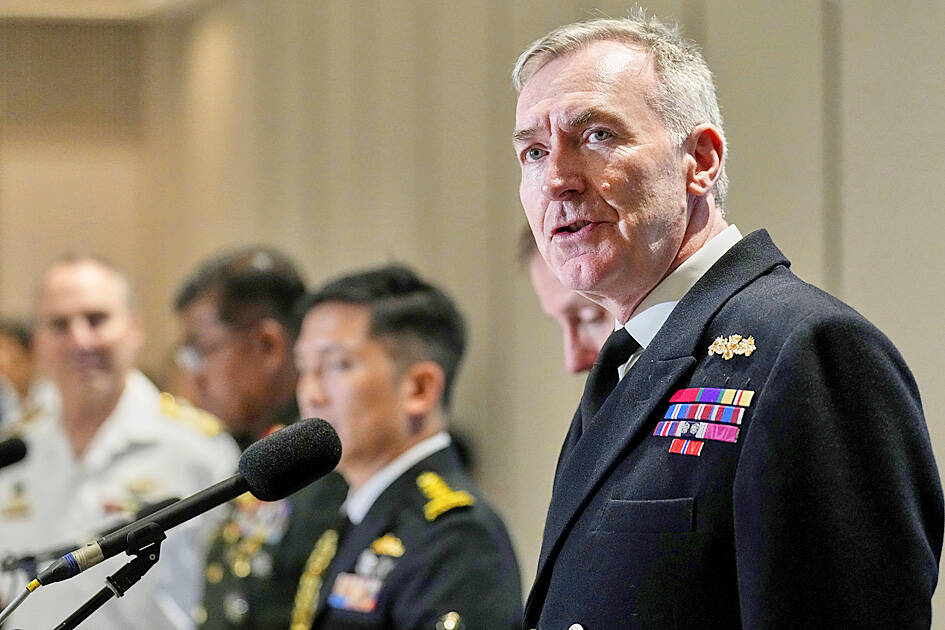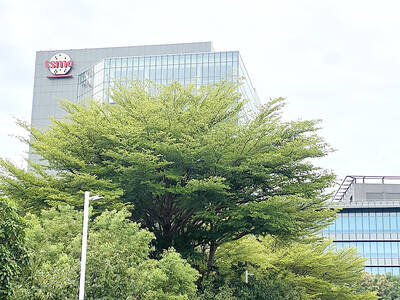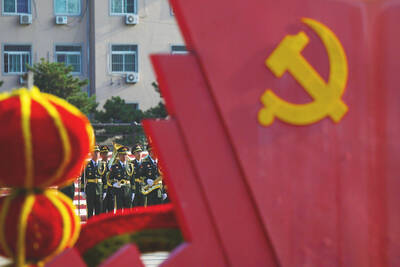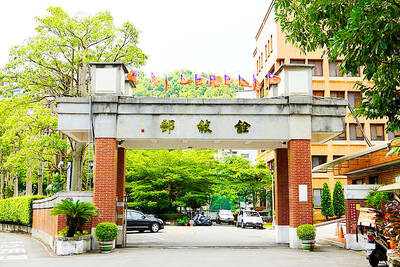Freedom of navigation in the Indo-Pacific region is as important as it is in the English Channel, British Chief of the Defence Staff Admiral Tony Radakin said at a summit in Singapore on Saturday.
The remark came as the British Royal Navy’s flagship aircraft carrier, the HMS Prince of Wales, is on an eight-month deployment to the Indo-Pacific region as head of an international carrier strike group.
“Upholding the UN Convention on the Law of the Sea, and with it, the principles of the freedom of navigation, in this part of the world matters to us just as it matters in the English Channel,” Radakin said at the Shangri-La Dialogue.

Photo: AP
“That is why the Royal Navy ships exercise the right of freedom of navigation, including in the Taiwan Strait and the South China Sea,” he added.
Radakin made the comment in a panel called “Cooperative Maritime Security in the Asia-Pacific” at the annual defense and security conference, while seated next to copanelist Hu Gangfeng (胡鋼鋒), head of the Chinese delegation and vice president of the Chinese People’s Liberation Army National Defense University.
China’s minister of national defense and high-level military officials were absent from the Shangri-La Dialogue this year.

Photo: British MOD via EPA-EFE
The HMS Prince of Wales set off from the UK in late April and is now operating in the Red Sea. It is to enter the waters of the Indo-Pacific region in the coming weeks, and aims to declare “full operational capability” during deployment.
It marks the first major Royal Navy deployment to the region since 2021, when a British carrier strike group, led by the HMS Queen Elizabeth, sailed into the Indo-Pacific region and announced “initial operating capability.”
The HMS Queen Elizabeth carrier strike group sailed through the Taiwan Strait in September that year, drawing anger and criticism from Beijing.

Photo courtesy of the Ministry of National Defense via CNA
“When we operate in this [Indo-Pacific] region, we do it in a very transparent way. It’s something that we are very comfortable doing,” Radakin said. “We see ourselves as operating under the rule of law, and we are doing activities that we consider to be entirely routine for a nation like the United Kingdom.”
“We are an active, responsible and reliable partner in the shared cause of global stability. That is also why the British government has chosen to deploy the aircraft carrier HMS Prince of Wales to the Indo-Pacific this year,” he said.
The English Channel has areas of British and French territorial waters, as well as international waters, but the innocent passage of foreign vessels is allowed in most of the channel.
On the other hand, China in recent years has ramped up the deployment of fighter jets and warships, and has been using “gray zone” tactics in an attempt to claim the Taiwan Strait as an “inner sea” and pressure Taipei into accepting its claims of sovereignty over the nation.
A Taiwanese security official yesterday said that China last month deployed two aircraft carrier groups and dozens of ships in waters north and south of Taiwan.
From May 1 to Tuesday last week, up to 70 Chinese ships, including navy vessels, were monitored from the Yellow Sea to the South China Sea, the official said on the condition of anonymity.
“Its military actions and ‘gray zone’ activities have included large-scale deployments across the entire island chain, involving comprehensive maximum pressure,” the official said. “On average, there have been between 50 to 70 naval vessels and government ships, as well as hundreds of sorties by various military aircraft continuously conducting harassment operations.”
Some of the ships passed through the Miyako Strait to the western Pacific Ocean for “long-distance training, including combined air-sea exercises,” the official said.
Another 30 Chinese vessels with no names, documentation or ports of registry were detected near Penghu on May 19 and were “deliberately sent to harass” Taiwan, the official said.
A total of 75 Chinese aircraft conducted three “combat-readiness patrols” near Taiwan last month, Ministry of National Defense figures showed.
Asia-Pacific’s first island chain links Okinawa, Taiwan and the Philippines, while the Yellow Sea is west of South Korea — all partners of the US and critical to its influence in the region.
China’s activities last month were “more provocative than previously observed,” the official said, citing an incident in which Tokyo and Beijing exchanged diplomatic protests accusing the other of “violating” national airspace, after a Chinese helicopter and coast guard vessels faced off with a Japanese aircraft around disputed islands.
China’s actions were a demonstration of “military expansion” and were aimed at controlling the “entire island chain and improving their capabilities,” the official said.
The deployment coincided with President William Lai’s (賴清德) speech on May 20 marking his first year in office and came ahead of the annual Shangri-La Dialogue.

Taiwan Semiconductor Manufacturing Co (TSMC, 台積電) is expected to start construction of its 1.4-nanometer chip manufacturing facilities at the Central Taiwan Science Park (CTSP, 中部科學園區) as early as October, the Chinese-language Liberty Times (the Taipei Times’ sister newspaper) reported yesterday, citing the park administration. TSMC acquired land for the second phase of the park’s expansion in Taichung in June. Large cement, construction and facility engineering companies in central Taiwan have reportedly been receiving bids for TSMC-related projects, the report said. Supply-chain firms estimated that the business opportunities for engineering, equipment and materials supply, and back-end packaging and testing could reach as high as

CHAMPIONS: President Lai congratulated the players’ outstanding performance, cheering them for marking a new milestone in the nation’s baseball history Taiwan on Sunday won their first Little League Baseball World Series (LLBWS) title in 29 years, as Taipei’s Dong Yuan Elementary School defeated a team from Las Vegas 7-0 in the championship game in South Williamsport, Pennsylvania. It was Taiwan’s first championship in the annual tournament since 1996, ending a nearly three-decade drought. “It has been a very long time ... and we finally made it,” Taiwan manager Lai Min-nan (賴敏男) said after the game. Lai said he last managed a Dong Yuan team in at the South Williamsport in 2015, when they were eliminated after four games. “There is

Democratic nations should refrain from attending China’s upcoming large-scale military parade, which Beijing could use to sow discord among democracies, Mainland Affairs Council Deputy Minister Shen You-chung (沈有忠) said. China is scheduled to stage the parade on Wednesday next week to mark the 80th anniversary of Japan’s surrender in World War II. The event is expected to mobilize tens of thousands of participants and prominently showcase China’s military hardware. Speaking at a symposium in Taichung on Thursday, Shen said that Chinese Minister of Foreign Affairs Wang Yi (王毅) recently met with Indian Prime Minister Narendra Modi during a visit to New Delhi.

FINANCES: The KMT plan to halt pension cuts could bankrupt the pension fund years earlier, undermining intergenerational fairness, a Ministry of Civil Service report said The Chinese Nationalist Party (KMT) caucus’ proposal to amend the law to halt pension cuts for civil servants, teachers and military personnel could accelerate the depletion of the Public Service Pension Fund by four to five years, a Ministry of Civil Service report said. Legislative Speaker Han Kuo-yu (韓國瑜) on Aug. 14 said that the Act Governing Civil Servants’ Retirement, Discharge and Pensions (公務人員退休資遣撫卹法) should be amended, adding that changes could begin as soon as after Saturday’s recall and referendum. In a written report to the Legislative Yuan, the ministry said that the fund already faces a severe imbalance between revenue